Xerente
- Self-denomination
- Akwê
- Where they are How many
- TO 3964 (Siasi/Sesai, 2020)
- Linguistic family
- Jê
The 250 years of contact of the Xerente with non-indigenous peoples have not affected their ethnic identity. The rapid and intense social, political, and economic transformations which affect the region in which they live have actually provided these people an opportunity to participate actively - although not without difficulties - in the decision-making processes which involve them. In the eye of the hurricane of economic development of the State of Tocantins, the Xerente continue to express by other means what is most traditional of them: their warrior ethos.
Name
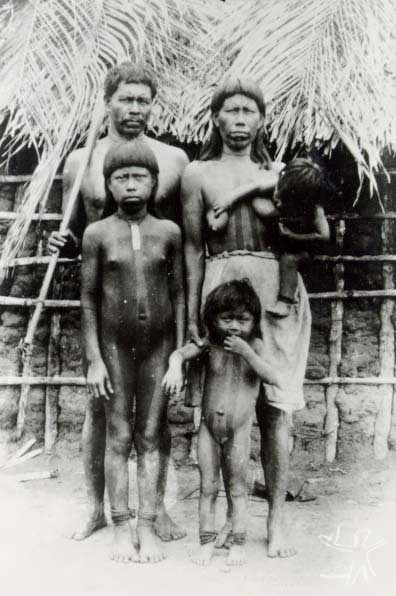
The Xerente, whose self-designation is Akwe, form, along with the Xavante (self-designation A'we) of Mato Grosso, the central branch of the societies of the Jê language family. The Xacriabá, presently located in Minas Gerais, and Acroás (extinct), are also considered groups which are culturally and linguistically related to them. According to the most accepted version, the name Xerente was attributed to them by non-Indians, por the purpose of differentiating them from other Akwe, particularly the Xavante.
Language
The Xerente and Xavante speak dialects of the same language, which belongs to the Jê family. The Xerente have maintained their dialect alive. Children up to five years of age only speak the indigenous language. The adults use it in all contexts of daily life in the villages. When they converse with non-Indians, they speak Portuguese fluently.
Location
Xerente territory - comprised of the Xerente and Funil indigenous lands ("terras indígenas") - is located in the brushlands of the State of Tocantins, to the east of the Tocantins River, 70 kilometers to the north of the capitol city, Palmas. The city of Tocantínia, located between the two indigenous reserves, has been over the past century, the stage of tensions between the local non-Indian population and the Xerente. Since the creation of the State of Tocantins, in 1989, their territory has been the focus of regional (and national) attention due to its strategic location. It is presently surrounded by development projects stimulated by the federal and state governments, in partnership with private initiative. Noteworthy among these projects are: PRODECER III, the Hydroelectric complex of Lageado and the expansion of the capitol of the state, Palmas. The Araguaia-Tocantins waterway, which is in process of environmental licensing, will have as one of its channels the right bank of the Tocantins River, passing through the 12 kilometers of the western border of Xerente territory. These projects are mostly supported by international capital (particularly from the Japanese), which is interested in the production of grains, mainly soybeans. As a result, the Xerente have been pressured, principally by the state government administration and by non-Indian residents of the neighboring cities, to accept the paving of roads which would cut through their territory and interconnect most of the projects referred to above.
Population
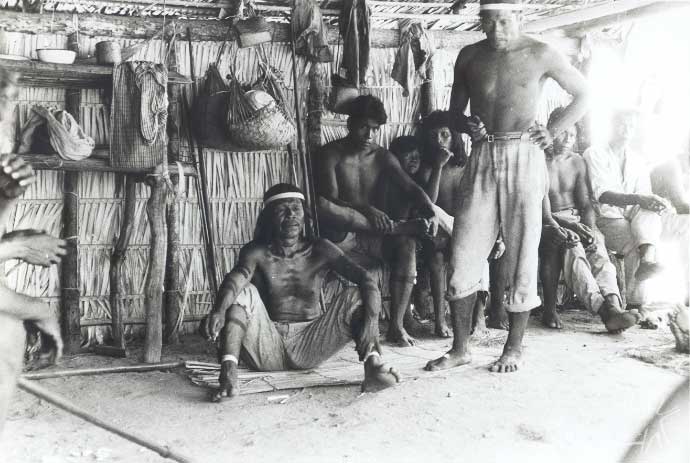
The Xerente presently have a population of nearly 1,800 people distributed in 33 villages. Estimates of the Xerente population have been presented at various moments in history as follows: 2,200 in 1851 (Frei Rafael de Taggia); 1,360 in 1924 (Urbino Viana); 330 in 1963 (Maybury-Lewis); 700 in 1982 (Pastor Rinaldo de Mattos); 1,000 in 1987 (FUNAI).
History of contact
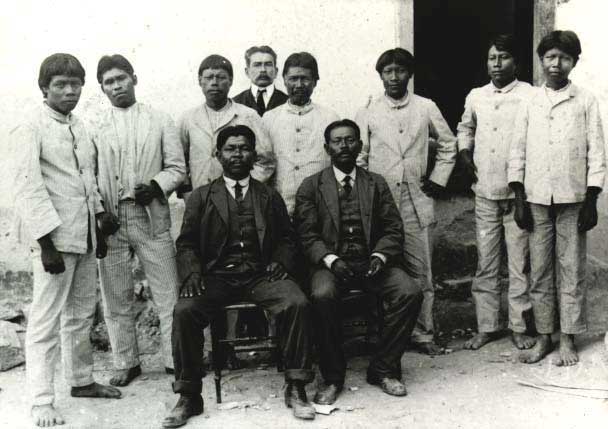
There are several indigenous oral histories the content of which raise the possibility that the Akwe in ancient times occupied areas close to the sea. However, official historiography points out that the first contacts between the Akwe and non-indigenous segments of society occured in the 17th Century, with the arrival of Jesuit missions and colonizers (frontier expeditions and raids) to the Brazilian central West.
In the 18th Century, with the discovery of gold mines, the colonization of the indigenous territories located in what was then called the Captaincy of Goiás intensified. Between 1750 and 1790, historical records indicate the construction of the first indigenous settlements financed by the Portuguese Crown. The objective of these settlements was to open up the territory through the attraction and pacification of the various indigenous peoples located there. Part of the Akwe (the Xavante, Xerente, Acroá, Xacriabá), besides the Javaé and Karajá, among others, lived temporarily in several of these settlements (Duro, Formiga and Pedro III, also known as Carretão), but later they rebelled and fled into less populated regions, to the north of the Captaincy.
In the second decade of the 19th Century, the government of the Province created indigenous military prisons in the northern part of the region, still considered "infested" with Xavante and Xerente, with the intention of securing navigation on the Araguaia River. Indigenous resistance persisted, with attacks on the military prisons and the non-Indian towns. For that reason, new attempts at settlement, particularly of the Akwe, were undertaken by Capuchin priests, relying on the support of punitive interventions by government military forces. In one of these settlements, called Teresa Cristina - today, the municipality of Tocantínia - Frei Raffael de Taggia, in 1851, indicated the existence of more than 3,000 Xavante and Xerente. According to the most accepted hypothesis, the definitive separation of these two Akwe groups took place at the end of the 19th Century: the Xavante are supposed to have migrated to the Mato Grosso brushlands, near the River of the Dead (rio das Mortes), while the Xerente remained on the banks of the Tocantins River.
The 20th Century was marked by the difficulties of Xerente survival because of squatters and ranchers who invaded the little that was left of their vast territory of traditional occupation. It was only during the 1940s that the SPI (Indian Protection Service, Serviço de Proteção aos Índios) installed two assistance posts, principally because of the reports by the ethnologist Curt Nimuendajú, who denounced the terrible living conditions of the Xerente. In this period, a Baptist mission came to the region, and has stayed among the Xerente until the present day. Historical records show that the concern of the authorities over the demarcation of an area for the group dates from the end of the 1950s. In 1972, after more than 200 years of tense and conflictive living together with diverse non-indigenous segments - which resulted in deaths on both sides -, the Xerente succeeded in getting their first demarcated area, which was called in the FUNAI documents "Área Grande"[Big Area]. Twenty more years and much struggle were necessary to get another area claimed by the Xerente, that of Funil, demarcated and homologated.
Subsistence modes
The Xerente exploited the resources of the brushlands through hunting and gathering, associated with a complementary swidden agriculture. Extensiveness of territory was thus always a basic condition for the constitution and reproduction of the group. It is not by chance that Xerente male identity is directly associated with being considered a "good hunter", a "good walker" and "runner." Hunting, fishing, and gathering activities, as well as agriculture, are intimately associated with the knowledge that the Xerente have of nature, its potentials and limitations.
The cycle of activities dedicated to agriculture is divided between the dry season - which they call "summer" - and the rainy season - called "winter." The first covers the months of May to September, and the second, from October to April. The great majority of the gardens are located in the immediate vicinity of the villages, near rivers and streams close to the galley-forests. Another type of garden which is much used by the Xerente is made near the banks of the Tocantins River, on nearly the whole western frontier of the territory, about 12 kilometers in length. The process of making most gardens (felling, burning, slashing, planting and gathering) relies on the participation of a specific residential segment (parents, unmarried sons, married daughters, and daughters' husbands), although, in several villages, under the leadership of the chief, larger-sized gardens are planted, which involves the participation of various residential segments. In the first case, the produce of the garden is distributed among the menbers of a specific residential segment, and in the second, among the residents of an entire village.
Other important items in the basic diet of the Xerente, such as honey, fruits, and various roots, are obtained through gathering, an activity by which they also obtain medicinal plants. Fishing, which once was an important source of food for the Xerente, has progressively declined in importance over the years, due to the impact of the large-scale development projects (dams, hydroelectrics) undertaken on the Tocantins River. Hunting also has gotten much scarcer due to the pressures on natural resources.
In compensation, the Xerente have sought other sources of income. The making and selling of artwork - basketry, warclubs, bows and arrows, collars, etc. - despite being very depreciated by the regional population, is one of the principal activities developed by the group, since the raw material utilized (buriti-fibres, sawgrass seeds, coco straw, etc) is accessible to the whole population. Part of the Xerente residential segments presently obtains financial resources through jobs they've gotten through Funai (drivers, post assistants), the State (indigenous teachers, health agents), or from retirement pensions for the elderly.
Social organization and Cosmology
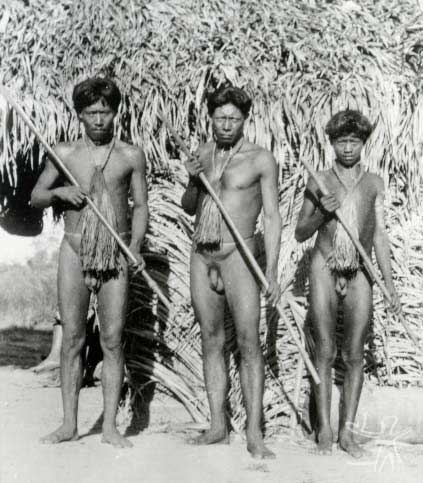
Studies of the Jê people point out as one of their principal characteristics the co-existence of a "simple" technological system - adapted to environmental conditions - and an extremely complex sociocultural system. These sociocultural systems are organized by means of a structural dualism which is manifest in a multiplicity of halves or moieties on the social plane. In the case of the Xerente, this is expressed in complex rituals, male cerimonial groups, naming groups, age classes, sports teams, etc., which are organized on the basis of kinship relations. The basis of this ordering is centered on a division in two socio-cosmological halves - Doí e Wahirê - associated respectively with the Sun and Moon, the mythical founding heroes of Xerente society. The jaguar (huku) is also part of the Xerente mythical system, since it was responsible for teaching them the use of fire. The Doí moiety includes the Kuzaptedkwá ("the owners of fire"), Kbazitdkwá ("the owners of cotton") and Kritóitdkwa ("the owners of the hot potato game" or "owners of rubber") clans; and the Wahirê moiety, the Krozaké, Kreprehí and Wahirê clans, the last of which has the same name as the moiety. The two moieties and their respective clans share amongst themselves a network of reciprocal duties and obligations. The moieties, the six clans and the lineages that constitute them are patrilinear, that is, they trace descent from father to son, from paternal grandfather to grandson, or nephew-grandson. Thus, each one of the Xerente clans owns a set of proper names which are passed down from generation to generation, and which identify and distinguish Xerente individuals on the plane of their social organization.

Another fundamental mechanism for the identification and location of the Xerente in a broader way in their sociocultural universe is through body painting. There are two basic painting motifs that guide this form of identification: the line, indicating that the individuals belong to one of the clans of the Wahirê moiety, and the circle, which identifies those belonging to the clans of the Doí moiety. Xerente adults paint their bodies only on cerimonial occasions. Children, on the other hand, are painted daily. The paintings among adults can be related to various spheres of social and cerimonial organization - age classes, festival groups, log-racing groups, marriages, funerals, etc. The basic colors of Xerente body painting are produced with the following ingredients: carbon mixed with milkwood makes black; urucum seeds make red, and white is made from parakeet down or cotton. Before painting, bodies are anointed with babaçu oil. The details - circles or lines - are engraved on pieces of buriti pith, and utilized as a sort of "stamp".
In the famous buriti log races, which reaffirm the ever present dual division among the Xerente, each one of the teams - Steromkwá and Htamhã - carries a log that is engraved and ornamented with motifs related to the figures of the sucuri and the jabuti respectively. One of the attributes of the shamans is to ornament the logs, in order to request the protection of the spirits of the forest. It is noteworthy that one of the sports most appreciated by Xerente men at the present time, besides the buriti log races, is without a doubt, soccer.
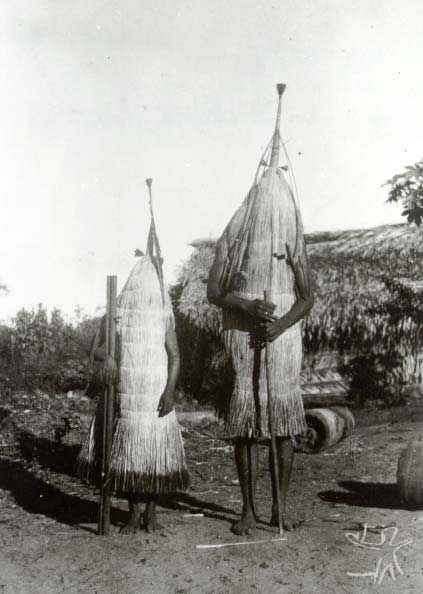
The Xerente cosmovision is directly associated with the various elements that comprise the natural world that surrounds them. With the processes of missionary evangelization - Catholic and Protestant - the Xerente have incorporated and re-elaborated the values of these religions, without, however, abandoning their own values. This is evident in the active participation of the shamans in the social and political life of the group. Except for three large settlements which are still maintained (with more than 150 people in each), presently, the other Xerente villages have between 10 to 50 people. The residence rule is uxorilocal: the son-in-law lives in the village (or in the residential segment) of his wife's father. Generally, the Xerente do not place restrictions on interethnic marriages with non-Indian women, but they explicitly disapprove of marriages of Xerente women with non-Indian men, although these do occur. All non-Indians (men and women) married to Xerente individuals are incorporated into the networks of kinship and consequently to the cerimonial and political systems of the group, thereby acquiring rights and duties that are identical to the rest.
Politics
Political relations - expressed in rituals, in body painting and, principally, through an intense factionalism - are based on a series of rights and duties stipulated by kinship relations. They are also guided by the contextual articulations of factions with the diverse non-indigenous agents of contact present in the region (the Indigenist Missionary Council, the Attorney General of the Republic, the state government, the municipal prefecture, the National Indian Foundation, the Baptist Mission, etc). The Xerente factions - which are groups of individuals (consanguineal and affinal kin) who give their support to one (or more) indigenous leaders - live in constant competition, seeking political dominion of each one of the villages, as well as of communication and articulation with the other non-Indian agents. This dynamic generates divisions, increasing the number of villages and chiefs, and, as a result, new political, social, and cerimonial arrangements are formed. To get an idea of this dynamic process, up until 1988, there were nine Xerente villages. Today there are 33. However, such alterations do not necessarily involve the rejection of kinship ties, nor do they put in check the internal unity of the group. The political roles with greater authority are the chief, the shaman, and members of the council of elders (wawes).
New forms of political leadership have been gaining ground among the Xerente, such as coordinators of associations and indigenous teachers. In political-institutional terms, the Xerente had a councilman in the municipal council of Tocantínia during the legislative period from 1992 to 1996. Due to inexperience and local anti-indigenous political pressures, there was a very great distance between the elected councilman and the Xerente, which led the group to temporarily discredit this type of initiative. Nevertheless, in the municipal elections of 1996, only a few more votes were needed to elect two Xerente candidates as councilmen in Tocantínia. The more than 600 Xerente voters (between men and women), have a decisive importance in local party politics. There are denunciations on the part of indigenous leaders that the electoral process (voting and, especially, the counting of votes) is manipulated to their detriment. The non-Indian residents of Tocantínia show by "jokes" that they are afraid that this municipality - encrusted in Xerente territory - may become the "first indigenous municipality of Brazil". The first direct experience of the Xerente with indigenous associations - the founding and operating of the Xerente Indigenous Association (XIA) from 1992 to 1995 - relied on the political assessment and direct economic support of the local CIMI, in partnership with an NGO from Luxemburg, the BRIDDERLECH DEELEN. In its nearly four years of operation, the Association implemented a series of economic projects that included all of the villages, which facilitated the beginning of Xerente autonomy from the complicated local network of political and economic relations. The Association closed at the end of 1995. Various Xerente leaders state that one of the principal motives for the end of the XIA was also related to local political pressures. From 1998 on, the Xerente - by then more experienced in relation to this type of organizational form - founded three new indigenous associations, each of which brought together specific nuclei of villages closest to each other in terms of political, cerimonial and spatial relations.
Health and education
The health conditions of the Xerente are quite reasonable, evidently, when contrasted to the precarious situation of various indigenous peoples in Brazil. They have a birth rate of close to 4%, well above the national average. Sicknesses such as malaria and yellow fever, which were in large part the cause of the drastic population reduction of the group up until the 1960s, today have been erradicated. Today, the sicknesses of greatest incidence among the Xerente are verminoses, flus, dysentery, bronquitis, pneumonia, rheumatism, conjunctivitis, scabies and tonsilitis. In the two cities most often visited by the Xerente - Miracema and Tocantínia - there are records of cases of AIDS among non-Indians, a fact which must be considered with some concern, since interethnic love affairs and marriages are common. A serious problem which mostly affects part of the adult male Xerente population is alcoholism, which, besides demoralization, debilitates the organism, making it more susceptible to illnesses. Health assistance is available both in the indigenous villages and in the nearest cities. In the villages there are indigenous health agents, trained through courses supported by accords between the Funai, the Prefecture of Tocantínia and the state government. In the cities, the Xerente seek assistance from the Unified Health System (SUS) post of the federal government in Tocantínia, the maternity ward and hospital of Miracema, or even the medical team of Funai in the Casa do Índio [House of the Indian] in the municipality of Gurupi.
The Xerente have already gone through various educational experiences: catechization by the Capuchinos (in the second half of the 19th Century) and Dominicans (in the first three decades of the 20th). Bilingual training has been sponsored by the Baptist missionaries since the 1950s. More recently (the 1980s), various kinds of specific support have been provided by other non-indigenous organizations and individuals - missionaries of CIMI, employees of Funai, anthropologists, the government of the State of Tocantins, the Federal University of Goiás. Formal school instruction in the villages, administered by around 30 indigenous teachers of both sexes (nearly one per village), is restricted to elementary education from the first to fourth grades. After finishing the fourth grade, continuing one's studies becomes more difficult because of problems of transportation and adaptation to the demands of non-indigenous schools, since secondary schools (which have from fifth to eighth grades) and high schools are located in Miracema and Tocantínia. But, even so, several Xerente have succeeded in graduating from secondary schools - with technical courses in education, administration, and accounting. Another alternative for students who have completed the fourth grade is to enroll in agricultural schools (boarding schools) at Catalão (GO). Presently, two Xerente are enrolled in state universities (in agricultural engineering and business administration).
Note on the sources
This entry is partly a synthesis of various researches done among the Xerente over the past century. The most inclusive ethnographic monographs on the group are those by Curt Nimuendajú (in the 1930s) and Agenor Farias (in the 1980s). The researches undertaken by the North American anthropologist David Maybury-Lewis (1956, 1963 and 1984) are focused on the study of political relations and their articulation with the social structure of the group and are published in the volume Dialectical Societies (1979). In his book The Savage and the Innocent, Maybury-Lewis presents a personal account of his field experiences among the Xerente and Xavante, a very accessible reading for the non-specialized public.
The article "Pintura corporal e sociedade, os partidos Xerente" (1992) [Body painting and society, Xerente parties], by Aracy Lopes da Silva and Agenor Farias, highlights, as the title indicates, the importance of the use of body painting in various contexts of Xerente social life, as well as succinctly presenting the main ideas contained in the works of Curt Nimuendajú, David Maybury-Lewis and Agenor Farias. More recently, Suzana Guimarães (1996), in her Master's thesis, performed a detailed analysis on the use of writing and orality among the Xerente. There is a vast amount of documents on various questions involving these people (environmental impact reports, legal processes, anthropological reports, newspaper reports etc.) which can be found in the Regional Administration of Funai of Tocantins, the Regional Attorney General of the Republic (TO) and the Regional CIMI. Besides the author of this entry, two students of the University of Brasília are presently developing research among the Xerente.
Sources of information
- ALENCASTRE, José Martins Pereira de. Anais da Província de Goiás. Brasília : Sudeco/ Governo de Goiás, 1979.
- AUDRIN, J. M. Entre sertanejos e índios do norte : o bispo/missionário Dom Domingos Carrérot. Rio de Janeiro : Agir, 1947.
- AZANHA, Gilberto; LADEIRA, Maria Elisa. Estudo de Impacto Ambiental Hidrelétrica do Lageado : componente indígena sobre os Xerente. São Paulo : Themag Engenharia, 1996.
- BRAGGIO, Silvia Lúcia Bigonjal. A instauração da escrita entre os Xerente : conflitos e resistências. Rev. do Museu Antropológico, Goiânia : UFGO, v. 3/4, n. 1, p. 19-42, jan./dez.99/00.
- BRASIL, Americano. Cunha Mattos em Goyas, 1824-1826. Rev. do IHGB, Rio de Janeiro : IHGB, tomo 96, v. 150, p. 182-205, 1924.
- FARIAS, Agenor José Teixeira Pinto. Fluxos sociais Xerente : organização social e dinâmica das relações entre aldeias. São Paulo : USP, 1990. 196 p. (Dissertação de Mestrado).
- --------. Notícia histórica sobre os Akwen-Xerente. Boletim do MPEG, Série Antropologia, Belém : MPEG, v. 10, n. 1, p. 21-41, jul. 1994.
- --------. Ritual e parentesco na sociedade Xerente contemporânea. Rev. de Antropologia, São Paulo : USP, v. 37, p. 309-31, 1994.
- GORDON, Cesar. Aspectos da organização social Jê : de Nimuendajú à década de 90. Rio de Janeiro : Museu Nacional, 1996. (Dissertação de Mestrado)
- GUEDES, Marymarcia. Siwiá Mekaperera-Suyá : a língua da gente - um estudo fonológico e gramatical. Campinas : Unicamp, 1993. (Tese de Doutorado)
- GUIMARÃES, Susana Martelletti Grillo. A aquisição da escrita e diversidade cultural : a prática de professores Xerente. Brasília : UnB, 1996. 164 p. (Dissertação de Mestrado)
- KRUNOMORI, Viturino. A história da andorinha "Brupahi". s.l. : Cimi-GO/TO, 1994. 28 p. (Mitologia do Povo Xerente, 4)
- --------. A história do Wakedi "Wake Waskuze". s.l. : Cimi-GO/TO, 1995. 21 p. (Mitologia do Povo Xerente, 21)
- --------. Ktekrsu Waskuze. s.l. : Cimi-GO/TO, 1993. 27 p. (Mitologia do Povo Xerente, 3)
- --------. Kunmã krewatbroze waskuze. s.l. : Cimi-GO/TO, 1991. 32 p. (Mitologia do Povo Xerente, 1)
- --------. Sruru : a história do "Sete Estrelo". s.l. : Cimi-GO/TO, 1992. 20 p. (Mitologia do Povo Xerente, 2)
- LUZ, Edward Mantoanneli. As festas Xerente : ritual e política em uma situação de liminaridade nas relações interétnicas entre a sociedade Xerente e parcelas da sociedade nacional. Brasília : UnB, 1999. (Monografia de Graduação)
- MAGALHÃES, Basílio. Prefácio de "Algumas notas sobre os Xerente". Rev. do Instituto Histórico e Geográfico Brasileiro, Rio de Janeiro, IHGB, tomo 101, v. 155, 1927.
- MAYBURY-LEWIS, David. Dialectical societies : the Gê and Bororo of Central Brazil. Cambridge : Harvar University Press, 1979.
- --------. On Martius’ distinctions between Shavante and Sherente. Rev. do Museu Paulista, São Paulo : Museu Paulista, n. 16, p. 263-88, 1974.
- --------. O selvagem e o inocente. Campinas : Ed. da Unicamp, 1990. 430 p.
- --------. A sociedade Xavante. São Paulo : Francisco Alves, 1984. 400 p.
- MONSERRAT, Ruth. Línguas indígenas no Brasil contemporâneo. In: GRUPIONI, Luís Donizete Benzi (Org.). Índios no Brasil. Brasília : Ministério de Educação e Desporto, 1994. p. 93-104.
- NIMUENDAJÚ, Curt. The Serente. Los Angeles : The Southwest Museum, 1942. 116 p.
- OLIVEIRA, José F. Os Cherentes aborígenes do Brasil Central. Rev. do Instituto Histórico e Geográfico do Brasil, Rio de Janeiro : IHGB, tomo 20, p. 14-25, 1921.
- PALACIN, Luiz. Coronelismo no extremo norte de Goiás. Goiânia : UFGO/Loyola, 1990.
- PAULA, Luís Roberto de. A dinâmica faccional Xerente : esfera local e processos sociopoliticos nacionais e internacionais. São Paulo : USP, 2000. 287 p. (Dissertação de Mestrado)
- --------.Descaminhos do Programa de Compensação Ambiental. In: Ricardo, Carlos Alberto; Ricardo, Fany. (Org.). Povos Indígenas no Brasil. São Paulo: Instituto Socioambiental (ISA), 2006, v. 2005, p. 712-714.
- --------. Estudo de Impacto Ambiental da hidrovia Araguaia-Tocantins : diagnóstico sócio-econômico e avaliação de impacto aos Xerente. s.l. : Ahitar, 1998. 89 p.
- --------. Plano de manejo ambiental sobre a pavimentação da TO-010 : componente indígena sobre os Xerente. Palmas : Secretaria de Transporte, 1998.
- POHL, Johann Emanuel. Viagem no interior do Brasil (1817-1821). São Paulo : Edusp ; Belo Horizonte : Itatiaia, 1976. 417 p. (Reconquista do Brasil, 14)
- POLECK, Lydia (Org.). Cobras da Área Xerente. Goiânia : UFGO ; Brasília : Funai, 1994. 21 p. (Textos Indígenas, Série Natureza)
- -------- (Org.). Festas indígenas Xerente. Goiânia : UFGO ; Brasília : Funai, 1994. 27 p. (Textos Indígenas, Série Cultura)
- -------- (Org.). Receitas Xerente. Goiânia : UFGO, 1998. 52 p. (Textos Indígenas, Série Receitas)
- QUEIROZ, Maria Isaura Pereira de. A noção de arcaísmo em etnologia e a organização social dos Xerénte. In: SCHADEN, Egon. Leituras de etnologia brasileira. São Paulo : Companhia Editôra Nacional, 1976. p. 127-38.
- RAVAGNANI, O. M. Aldeamentos goianos em 1750 : os jesuítas e a mineração. Rev. de Antropologia, São Paulo : USP, v. 30/32, p. 111-32, 1989.
- --------. A experiência Xavante com o mundo dos brancos. Araraquara : Unesp, 1991. (Dissertação de Mestrado)
- REIS, Francisco Carlos Oliveira. Aspectos do contato e formas socioculturais da sociedade Akwe-Xerente (Jê). Brasília : UnB, 2001. 128 p. (Dissertação de Mestrado)
- --------. Os rituais de nominação xerente e o contexto de contato. In: PEIRANO, Mariza G. S.,org. Análises de rituais. Brasília : UnB, 2000. p. 63-80. (Série Antropologia, 283)
- --------. Subsistência Akwê-Xerente : formas de manejo do ecossistema e projetos desenvolvimentistas em um grupo Jê. Brasília : UnB, 1999. (Dissertação de Graduação).
- SCHROEDER, Ivo. Política e parentesco nos Xerente. São Paulo : USP, 2006 (Tese de Doutorado)
- SILVA, Aracy Lopes da Silva. Dois séculos e meio de história Xavante. In: CUNHA, Manuela Carneiro da (Org.). História dos índios no Brasil. São Paulo : Companhia das Letras/ SMC, 1992. p. 357-78.
- --------. Nomes e amigos : da prática Xavante a uma reflexão sobre os Jê. São Paulo : USP, 1986. (Antropologia, 6)
- --------. Pequenos “xamãs” : crianças indígenas, corporalidade e escolarização. In: SILVA, Aracy Lopes da; MACEDO, Ana Vera Lopes da Silva; NUNES, Ângela (Orgs.). Crianças indígenas : ensaios antropológicos. São Paulo : Global ; Mari-USP, 2002. p. 37-63. (Antropologia e Educação)
- --------; FARIAS, Agenor T. P. Pintura corporal e sociedade, os "partidos" Xerente. In: VIDAL, Lux (Org.). Grafismo indígena. São Paulo : Nobel/Edusp, 1992. p. 89-116.
- SILVA, Otávio de Barros. Breve história do Tocantins e de sua gente : uma luta secular. Araguaína : Solo, 1997.
- SOUSA FILHO, Silval Martins de. A aquisição do português oral pela criança Xerente. Goiânia : UFGO, 2000. 180 p. (Dissertação de Mestrado)
- TAGGIA, Rafael (Frei). Mappa dos índios Cherentes e Chavantes na nova povoação de Teresa Cristina do rio Tocantins, aldeados em 24/06/1851. Rev. do Instituto Histórico e Geográfico do Brasil, Rio de Janeiro : IHGB, tomo 19, p. 119-22, 1856.
- VIANNA, Urbino. Algumas notas sobre os Xerente. Akuen ou Xerente. Ligeiras notas para a grammatica Skuen. Rev. do Instituto Histórico e Geográfico do Brasil, Rio de Janeiro : IHGB, tomo 101, v. 155, p. 6-96, 1927.
- WENZEL, Eugênio Gervásio. Laudo Antropológico processo nº 93.800-5, Justiça Federal/Seção Judiciária do Estado de Tocantins. s.l. : s.ed., 1995. 54 p. (AI: Xerente e Funil)